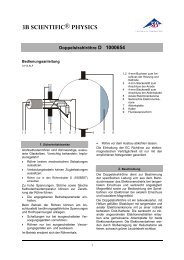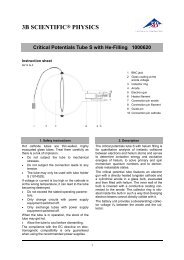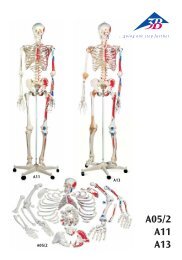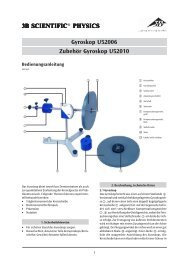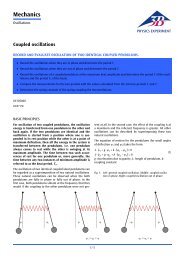Modelo de la célula vegetal - 3B Scientific
Modelo de la célula vegetal - 3B Scientific
Modelo de la célula vegetal - 3B Scientific
Create successful ePaper yourself
Turn your PDF publications into a flip-book with our unique Google optimized e-Paper software.
<strong>Mo<strong>de</strong>lo</strong> <strong>de</strong> <strong>la</strong> célu<strong>la</strong> <strong>vegetal</strong><br />
(ampliada aproximadamente <strong>de</strong> 500.000 a 1.000.000 <strong>de</strong> veces <strong>de</strong> tamaño)<br />
®<br />
Español<br />
Historia <strong>de</strong> <strong>la</strong> citología<br />
La citología es una ciencia autónoma <strong>de</strong>ntro <strong>de</strong> <strong>la</strong> botánica que estudia <strong>la</strong> estructura y <strong>la</strong>s funciones <strong>de</strong><br />
<strong>la</strong> célu<strong>la</strong> <strong>vegetal</strong>. La pa<strong>la</strong>bra célu<strong>la</strong> (<strong>de</strong>l <strong>la</strong>t. cellu<strong>la</strong>, diminutivo <strong>de</strong> cel<strong>la</strong> = hueco) fue empleada en 1665<br />
por Robert Hooke, <strong>de</strong>spués <strong>de</strong> que <strong>la</strong> <strong>de</strong>scubriera y <strong>la</strong> bosquejara <strong>de</strong>tal<strong>la</strong>damente, a partir <strong>de</strong>l tejido <strong>de</strong><br />
un corcho <strong>de</strong> botel<strong>la</strong>, al emplear uno <strong>de</strong> los primeros microscopios ópticos. A inicios <strong>de</strong>l siglo XIX, Franz<br />
Meyen (1804 – 1840) reconoció que <strong>la</strong> célu<strong>la</strong> constituía <strong>la</strong> unidad elemental <strong>de</strong> los órganos <strong>vegetal</strong>es. En<br />
1838/1839, Matthias Jacob Schlei<strong>de</strong>n y Theodor Schwann fundamentaron su teoría celu<strong>la</strong>r: “Los <strong>vegetal</strong>es<br />
y los animales están compuestos <strong>de</strong> igual manera por célu<strong>la</strong>s”. En 1845, Karl Theodor Ernst von Siebold,<br />
a partir <strong>de</strong> observaciones <strong>de</strong> protozoarios (organismos unicelu<strong>la</strong>res), señaló que <strong>la</strong>s célu<strong>la</strong>s pue<strong>de</strong>n vivir<br />
in<strong>de</strong>pendientemente <strong>de</strong> <strong>la</strong>s <strong>de</strong>más y que representan <strong>la</strong> más pequeña unidad dotada <strong>de</strong> vida. Al mismo<br />
tiempo, Louis Pasteur y otros científicos refutaron <strong>la</strong> teoría, válida en ese entonces, <strong>de</strong> que <strong>la</strong>s célu<strong>la</strong>s se<br />
pue<strong>de</strong>n generar espontáneamente a partir <strong>de</strong> materia orgánica muerta (generatio spontanea). En 1855,<br />
Rudolf Virchow confirmó <strong>la</strong> teoría <strong>de</strong> Meyen, <strong>de</strong> que cada célu<strong>la</strong> se reproduce <strong>de</strong> una célu<strong>la</strong> anterior<br />
(“omnis cellu<strong>la</strong> ex cellu<strong>la</strong>”). En 1879, Eduard Strasburger <strong>de</strong>scubrió <strong>la</strong> mitosis <strong>de</strong> <strong>la</strong>s p<strong>la</strong>ntas. En el año 1940<br />
se dio un paso importante hacia <strong>la</strong> comprensión <strong>de</strong> <strong>la</strong> estructura y el funcionamiento <strong>de</strong> <strong>la</strong> célu<strong>la</strong> gracias<br />
al <strong>de</strong>sarrollo <strong>de</strong>l microscopio electrónico <strong>de</strong> transmisión, hecho realizado por E. Ruska y H. Mahlt.<br />
Al igual que en los sistemas animales, <strong>la</strong>s célu<strong>la</strong>s <strong>vegetal</strong>es se distinguen por:<br />
• una organización más compleja que <strong>la</strong> <strong>de</strong> su entorno<br />
• reacción ante los estímulos internos y ante los <strong>de</strong>l exterior<br />
• capacidad <strong>de</strong> reproducción.<br />
Diferencias entre <strong>la</strong> estructura básica <strong>de</strong> <strong>la</strong>s célu<strong>la</strong>s animales y <strong>vegetal</strong>es<br />
A pesar <strong>de</strong> <strong>la</strong> concordancia encontrada en 1838 por Schlei<strong>de</strong>n y Schwann en lo re<strong>la</strong>tivo a <strong>la</strong>s célu<strong>la</strong>s <strong>vegetal</strong>es<br />
y animales, existen importantes diferencias en su estructura básica. La mayoría <strong>de</strong> <strong>la</strong>s célu<strong>la</strong>s <strong>vegetal</strong>es<br />
se diferencian <strong>de</strong> <strong>la</strong>s animales <strong>de</strong>bido a <strong>la</strong>s tres siguientes características:<br />
1. Las célu<strong>la</strong>s <strong>vegetal</strong>es se encuentran recubiertas por una membrana celu<strong>la</strong>r que resiste a <strong>la</strong> presión<br />
osmótica interna <strong>de</strong> <strong>la</strong> célu<strong>la</strong> (presión <strong>de</strong> turgor) y que <strong>la</strong>s dota <strong>de</strong> una resistencia más elevada.<br />
2. Sólo <strong>la</strong>s célu<strong>la</strong>s <strong>vegetal</strong>es poseen plástidos, a manera <strong>de</strong> organelos, entre los que se encuentran, por<br />
ejemplo, los clorop<strong>la</strong>stos ver<strong>de</strong>s, en don<strong>de</strong> se realiza <strong>la</strong> fotosíntesis.<br />
3. Poseen vacuo<strong>la</strong>s llenas <strong>de</strong> savia celu<strong>la</strong>r, típicas <strong>de</strong> <strong>la</strong>s p<strong>la</strong>ntas, en <strong>la</strong>s que se almacena <strong>la</strong> materia disuelta<br />
y se generan <strong>la</strong>s macromolécu<strong>la</strong>s.<br />
La célu<strong>la</strong> <strong>vegetal</strong> tiene un tamaño promedio <strong>de</strong> 10 a 100 µm y se <strong>la</strong> pue<strong>de</strong> observar con un microscopio<br />
óptico sencillo. ¡Un árbol está compuesto por una cantidad <strong>de</strong> hasta 10 13 (= 10 billones) <strong>de</strong> célu<strong>la</strong>s! En los<br />
organismos pluricelu<strong>la</strong>res, éstas se unen en familias <strong>de</strong> célu<strong>la</strong>s <strong>de</strong>l mismo tipo (tejidos), que presentan<br />
diferencias, en parte, fuertemente marcadas y, por tanto, funciones especiales.<br />
Estructura y funcionamiento <strong>de</strong> <strong>la</strong> célu<strong>la</strong> <strong>vegetal</strong><br />
(Para <strong>la</strong> numeración, véase <strong>la</strong> imagen)<br />
¡¡¡Importante: Al contrario <strong>de</strong>l mo<strong>de</strong>lo presente, los componentes <strong>de</strong> una célu<strong>la</strong> viva se encuentran<br />
en constante movimiento y fluyen!!!<br />
Los componentes individuales <strong>de</strong> <strong>la</strong> célu<strong>la</strong> poseen diferentes cantida<strong>de</strong>s, por ejemplo, <strong>de</strong> proteínas/ enzimas,<br />
medio iónico, etc., y para c<strong>la</strong>sificar<strong>la</strong>s <strong>de</strong> <strong>la</strong> manera más razonable posible se recurre a sus funciones.<br />
Un concepto importante <strong>de</strong> <strong>la</strong> citología <strong>vegetal</strong> es el <strong>de</strong> protop<strong>la</strong>sto, el cual <strong>de</strong>signa una célu<strong>la</strong> recubierta<br />
por una membrana <strong>de</strong> citop<strong>la</strong>sma <strong>de</strong> <strong>la</strong> que se ha <strong>de</strong>sprendido <strong>la</strong> membrana celu<strong>la</strong>r.<br />
Citop<strong>la</strong>sma con citoesqueleto (1)<br />
En el transcurso <strong>de</strong> <strong>la</strong> evolución, en el interior <strong>de</strong> <strong>la</strong> célu<strong>la</strong>, se impuso una especie <strong>de</strong> división <strong>de</strong>l trabajo,<br />
<strong>la</strong> cual recibe el nombre <strong>de</strong> compartimentalización. Esto se alcanza cuando <strong>la</strong>s áreas especiales <strong>de</strong> reacción,<br />
los organelos (<strong>de</strong>l griego Organon = herramienta), se recubren y limitan por medio <strong>de</strong> membranas.




